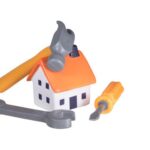Are you looking to give your home a makeover but lacking the funds to do so? This article will guide you on where to apply for a home improvement loan, making your renovation dreams a reality.
Home improvement loans play a crucial role in helping homeowners enhance their living spaces by providing the necessary financial support for renovations, repairs, or upgrades. Whether it’s creating your dream kitchen, adding an extra bedroom, or sprucing up your backyard, these loans can make it all possible.
When it comes to home improvement loans, there are various options available to choose from. Personal loans, home equity loans, and home equity lines of credit are among the most common types that offer different terms and benefits. Understanding the differences between each type can help you make an informed decision on which loan suits your specific needs best.
However, before rushing into applying for a loan, there are essential factors to consider. Interest rates, repayment terms, eligibility requirements – all these aspects need careful consideration to ensure you select the right loan option that fits your budget and goals.
To start your journey towards securing a home improvement loan, it is essential to explore the various financial institutions that offer such lending services. From traditional banks and credit unions to online lenders, there is no shortage of options available for borrowers. Each lender may have different offerings in terms of interest rates, application processes, and approval criteria. By researching and comparing these options thoroughly, you can find the best lender that aligns with your financial situation and renovation plans.
Types of Home Improvement Loans
Home improvement loans come in various forms, each with its unique features and benefits. One popular option is a personal loan, which is unsecured and typically has a fixed interest rate. Personal loans are often favored for smaller renovation projects due to their simplicity and quick approval process.
Another common choice is a home equity loan, which allows homeowners to borrow against the equity in their property. These loans usually have lower interest rates than personal loans because they are secured by the home itself.
For those who prefer flexibility in borrowing, a home equity line of credit (HELOC) may be the best option. A HELOC works similarly to a credit card, allowing homeowners to borrow funds as needed up to a certain limit using their home as collateral.
The interest rates for HELOCs are adjustable, meaning they can fluctuate over time based on market conditions. This type of loan is ideal for ongoing or larger renovation projects that require varying amounts of funds at different stages.
When deciding on the right type of home improvement loan for your project, it’s essential to consider factors such as the amount of money needed, repayment terms, interest rates, and your overall financial situation. By evaluating these aspects carefully, you can choose a loan that aligns with your specific needs and budget.
Now that you have an understanding of the different options available for home improvement financing, it’s time to explore where to apply for a home improvement loan to kickstart your renovation plans.
| Loan Type | Description |
|---|---|
| Personal Loan | Unsecured loan with fixed interest rates often used for smaller projects. |
| Home Equity Loan | Secured loan using property equity with lower interest rates ideal for significant renovations. |
| Home Equity Line of Credit (HELOC) | Flexible line of credit secured by home equity great for ongoing projects with variable funding needs. |
Factors to Consider Before Applying
Before diving into the process of applying for a home improvement loan, it’s crucial to consider various factors that will impact your borrowing experience. One of the first things to evaluate is the interest rate attached to the loan. Interest rates can vary depending on the type of loan you choose and your creditworthiness.
It’s essential to compare rates from different lenders to ensure you’re getting the best deal possible. Here is a checklist of factors to consider before applying for a home improvement loan:
- Interest Rates: Compare rates from different lenders to find the most competitive offer.
- Repayment Terms: Understand the repayment schedule, including monthly payments and total repayment amount.
- Eligibility Requirements: Check if you meet the lender’s criteria, such as credit score, income level, and debt-to-income ratio.
Additionally, it’s essential to assess your current financial situation and determine how much you can realistically afford to borrow. Consider creating a budget for your home renovation project to estimate costs accurately. This will help you avoid taking out a loan that could strain your finances in the long run.
Another crucial factor to think about is your existing equity in your home, especially if you’re considering a home equity loan or line of credit. Home equity loans use your home as collateral, so it’s vital to have enough equity built up before applying. On the other hand, personal loans may not require any collateral but typically have higher interest rates. Understanding these differences will help you choose the right type of loan for your specific needs.
Ultimately, taking the time to evaluate these factors before applying for a home improvement loan can save you money and ensure a smoother borrowing process. By being informed and prepared, you’ll be better equipped to make sound financial decisions when it comes to enhancing your living space.
Where to Start
When considering a home improvement project, finding the right financial institution to provide the necessary loan is crucial. There are various options available for homeowners looking to fund their renovations, including banks, credit unions, and online lenders. Each type of institution has its own set of advantages and considerations to keep in mind.
1. Banks: Traditional brick-and-mortar banks are a popular choice for obtaining home improvement loans. Banks offer stability and often have established reputations in the financial industry. They may also have specific loan products tailored for homeowners looking to renovate their properties. It is advisable to check with your local bank to see what options they have available and what terms they can offer.
2. Credit Unions: Credit unions are non-profit organizations that provide financial services to their members. They often offer competitive interest rates and personalized customer service. Additionally, credit unions may be more flexible in working with individuals who have less-than-perfect credit scores. If you are a member of a credit union, be sure to inquire about their home improvement loan offerings.
3. Online Lenders: In recent years, online lenders have become increasingly popular due to their convenience and quick approval processes. Websites like LendingTree, SoFi, or LightStream allow borrowers to compare multiple loan offers from different lenders easily. Online lenders may be a good option for those looking for flexibility in loan terms or specific requirements that traditional institutions may not offer.
Ultimately, when deciding where to apply for a home improvement loan, it is essential to research each type of financial institution thoroughly and compare their offerings. Consider factors such as interest rates, repayment terms, fees, and customer reviews before making a decision on which lender to choose for your renovation project. Taking the time to explore all your options will help ensure that you find the best loan that suits your needs and budgetary requirements.
Application Process
Home improvement loans can be a fantastic way for homeowners to fund renovations, repairs, and upgrades to their homes. Whether you’re looking to spruce up your kitchen, add an extra bedroom, or remodel your bathroom, these loans can provide the necessary financial support. But before diving into the application process, it’s essential to understand where to apply for a home improvement loan.
One of the most common places to apply for a home improvement loan is at traditional financial institutions such as banks and credit unions. These establishments often offer personal loans, home equity loans, and home equity lines of credit specifically designed for home improvements. Online lenders have also become increasingly popular in recent years, providing convenient access to loan options from the comfort of your own home.
When applying for a home improvement loan, it is crucial to gather all necessary documents beforehand. Lenders may require proof of income, tax returns, credit reports, estimates from contractors, and other financial information.
It’s also recommended to schedule meetings with potential lenders to discuss your renovation plans and ensure that you fully understand the terms and conditions of the loan. By being prepared with all the required documentation and having open communication with lenders, you can streamline the application process and increase your chances of approval.
| Financial Institutions | Loan Options |
|---|---|
| Banks | Personal loans, home equity loans |
| Credit Unions | Personal loans, home equity lines of credit |
| Online Lenders | Various options tailored for different needs |
Tips for a Successful Application
Improving Credit Score
One crucial factor that lenders consider when reviewing home improvement loan applications is the applicant’s credit score. A higher credit score often translates to better loan terms and higher chances of approval. Therefore, before applying for a home improvement loan, it is advisable to review your credit report and take steps to improve your credit score if necessary.
This can include paying off outstanding debts, correcting any errors on your credit report, and maintaining a good payment history on existing accounts. By boosting your credit score, you can enhance your overall financial profile and increase your chances of securing a favorable home improvement loan.
Presenting a Detailed Renovation Plan
When applying for a home improvement loan, having a clear and detailed renovation plan can significantly improve your chances of approval. Lenders want to see how you intend to use the funds and ensure that the improvements will add value to your property.
Therefore, it is essential to provide a comprehensive outline of the planned renovations, including cost estimates, timeline, contractor quotes, and any necessary permits. By demonstrating that you have thoroughly thought out the project and have a solid plan in place, you can show lenders that you are a responsible borrower who is serious about investing in their property.
Seeking Professional Guidance
If you are unsure about the application process or need assistance in improving your credit score and developing a renovation plan, consider seeking professional guidance from financial advisors or housing counselors. These experts can provide valuable insights into the best strategies for securing a home improvement loan and increasing your chances of approval.
They can also help you understand the various options available and navigate the complex world of home improvement financing. By leveraging their expertise and guidance, you can position yourself as a strong candidate for a home improvement loan and make informed decisions regarding your renovation project.
Comparing Loan Offers
When considering taking out a home improvement loan, it is crucial to compare loan offers from different lenders to find the best terms and rates that suit your financial needs. With various financial institutions offering home improvement loans, it can be overwhelming to choose the right one. By comparing loan offers, homeowners can potentially save money in the long run and ensure they are getting the most favorable terms for their renovation projects.
Benefits of Comparing Loan Offers
One of the primary benefits of comparing loan offers is finding the most competitive interest rates available. Interest rates can vary significantly between lenders, which can have a substantial impact on the total amount repaid over the life of the loan. By shopping around and comparing offers, homeowners can secure a lower interest rate, resulting in potential savings on interest payments.
Furthermore, comparing loan offers allows borrowers to assess additional fees and charges associated with the loan. Some lenders may have origination fees, closing costs, or prepayment penalties that can add to the overall cost of borrowing. By carefully reviewing and comparing these fees from different lenders, homeowners can choose a loan with minimal additional charges, ultimately saving money on unnecessary expenses.
How to Compare Loan Offers
To effectively compare loan offers from different lenders, it is essential to request personalized quotes based on your financial information and credit score. This way, you can accurately evaluate each offer based on your specific circumstances. Look beyond just the interest rate and consider factors such as repayment terms, flexibility in borrowing amounts, and any special incentives offered by the lender.
Additionally, take into account customer reviews and ratings of each lender to gauge their reputation for customer service and reliability. By conducting thorough research and comparison shopping
Final Thoughts
In conclusion, home improvement loans can be a valuable tool for homeowners looking to enhance their living space and increase the value of their property. Whether it’s a small renovation project or a major remodeling endeavor, having access to financial assistance through various loan options can make all the difference.
By carefully considering factors such as interest rates, repayment terms, and eligibility requirements before applying for a loan, homeowners can ensure they are making the best choice for their specific needs.
When considering where to apply for a home improvement loan, it is essential to explore different financial institutions such as banks, credit unions, and online lenders. Each option may have its own advantages and disadvantages, so it’s crucial to compare offers from multiple sources to find the most favorable terms and rates. Taking the time to research and gather necessary documents before starting the application process can streamline the overall experience and increase the chances of approval.
Ultimately, taking the next steps in applying for a home improvement loan is an exciting opportunity to turn dream renovations into reality. By following the tips provided in this article on improving credit scores, presenting detailed renovation plans, and comparing loan offers from various lenders, homeowners can set themselves up for success.
With careful planning and smart decision-making throughout the application process, homeowners can secure the funding needed to transform their living spaces and create a home they truly love.
Frequently Asked Questions
Are Home Improvement Loans Hard to Get?
Home improvement loans can be challenging to obtain depending on various factors such as credit history, income, and the amount being requested. Lenders typically look for a good credit score, stable income, and equity in the home.
Can I Get a Loan to Improve My Home?
Yes, it is possible to get a loan specifically for home improvements. Many financial institutions offer home improvement loans that can help homeowners fund renovation projects or upgrades to their property. These loans are usually secured by the value of the home itself.
What Credit Score Is Needed for a Home Improvement Loan?
The credit score needed for a home improvement loan varies among lenders. Generally, a good to excellent credit score is desired to qualify for favorable terms and interest rates. Lenders may also consider other factors such as income and debt-to-income ratio in the approval process.

I’m thrilled to have you here as a part of the Remodeling Top community. This is where my journey as an architect and remodeling enthusiast intersects with your passion for transforming houses into dream homes.





